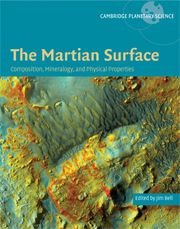Book contents
- Frontmatter
- Contents
- List of contributors
- Foreword
- Acknowledgments
- Part I Introduction and historical perspective
- Part II Elemental Composition: Orbital and in situ Surface Measurements
- Part III Mineralogy and Remote Sensing of Rocks, Soil, Dust, and Ices
- 7 Mineralogy of the Martian surface from Mars Express OMEGA observations
- 8 Visible to near-IR multispectral orbital observations of Mars
- 9 Global mineralogy mapped from the Mars Global Surveyor Thermal Emission Spectrometer
- 10 The compositional diversity and physical properties mapped from the Mars Odyssey Thermal Emission Imaging System
- 11 Mars' crustal magnetization: a window into the past
- 12 Multispectral imaging from Mars Pathfinder
- 13 Mars Exploration Rover Pancam multispectral imaging of rocks, soils, and dust at Gusev crater and Meridiani Planum
- 14 The mineralogy of Gusev crater and Meridiani Planum derived from the Miniature Thermal Emission Spectrometers on the Spirit and Opportunity rovers
- 15 Iron mineralogy and aqueous alteration on Mars from the MER Mössbauer spectrometers
- 16 Magnetic properties of Martian surface materials
- 17 Martian meteorites as crustal samples
- Part IV Physical Properties of Surface Materials
- Part V Synthesis
- Part VI Summary, Upcoming Missions, and New Measurement Needs
- Index
- Plate section
- References
13 - Mars Exploration Rover Pancam multispectral imaging of rocks, soils, and dust at Gusev crater and Meridiani Planum
from Part III - Mineralogy and Remote Sensing of Rocks, Soil, Dust, and Ices
Published online by Cambridge University Press: 10 December 2009
- Frontmatter
- Contents
- List of contributors
- Foreword
- Acknowledgments
- Part I Introduction and historical perspective
- Part II Elemental Composition: Orbital and in situ Surface Measurements
- Part III Mineralogy and Remote Sensing of Rocks, Soil, Dust, and Ices
- 7 Mineralogy of the Martian surface from Mars Express OMEGA observations
- 8 Visible to near-IR multispectral orbital observations of Mars
- 9 Global mineralogy mapped from the Mars Global Surveyor Thermal Emission Spectrometer
- 10 The compositional diversity and physical properties mapped from the Mars Odyssey Thermal Emission Imaging System
- 11 Mars' crustal magnetization: a window into the past
- 12 Multispectral imaging from Mars Pathfinder
- 13 Mars Exploration Rover Pancam multispectral imaging of rocks, soils, and dust at Gusev crater and Meridiani Planum
- 14 The mineralogy of Gusev crater and Meridiani Planum derived from the Miniature Thermal Emission Spectrometers on the Spirit and Opportunity rovers
- 15 Iron mineralogy and aqueous alteration on Mars from the MER Mössbauer spectrometers
- 16 Magnetic properties of Martian surface materials
- 17 Martian meteorites as crustal samples
- Part IV Physical Properties of Surface Materials
- Part V Synthesis
- Part VI Summary, Upcoming Missions, and New Measurement Needs
- Index
- Plate section
- References
Summary
ABSTRACT
Multispectral imaging from the Panoramic Camera (Pancam) instruments on the Mars Exploration Rovers (MERs) Spirit and Opportunity has provided important new insights about the geology and geologic history of the rover landing sites and traverse locations in Gusev crater and Meridiani Planum. Pancam observations from near-UV to near-infrared (NIR) wavelengths provide limited compositional and mineralogic constraints on the presence, abundance, and physical properties of ferric- and ferrous-iron–bearing minerals in rocks, soils, and dust at both sites. High-resolution and stereo morphologic observations have also helped to infer some aspects of the composition of these materials at both sites. Perhaps most importantly, Pancam observations were often efficiently and effectively used to discover and select the relatively small number of places where in situ measurements were performed by the rover instruments, thus supporting and enabling the much more quantitative mineralogic discoveries made using elemental chemistry and mineralogy data. This chapter summarizes the major compositionally and mineralogically relevant results at Gusev and Meridiani derived from Pancam observations. Classes of materials encountered in Gusev crater include outcrop rocks, float rocks, cobbles, clasts, soils, dust, rock grindings, rock coatings, windblown drift deposits, and exhumed whitish/yellowish sulfur- and silica-rich soils. Materials studied in Meridiani Planum include sedimentary outcrop rocks, rock rinds, fracture fills, hematite spherules, cobbles, rock fragments, meteorites, soils, and windblown drift deposits. This chapter also previews the results of a number of coordinated observations between Pancam and other rover-based and Mars-orbital instruments that were designed to provide complementary new information and constraints on the mineralogy and physical properties of Martian surface materials.
Information
- Type
- Chapter
- Information
- The Martian SurfaceComposition, Mineralogy and Physical Properties, pp. 281 - 314Publisher: Cambridge University PressPrint publication year: 2008
References
Accessibility standard: Unknown
Why this information is here
This section outlines the accessibility features of this content - including support for screen readers, full keyboard navigation and high-contrast display options. This may not be relevant for you.Accessibility Information
- 10
- Cited by
